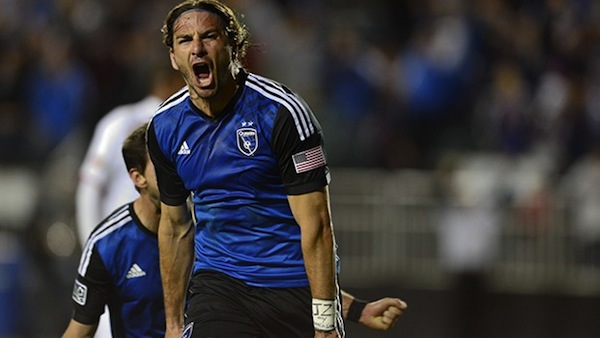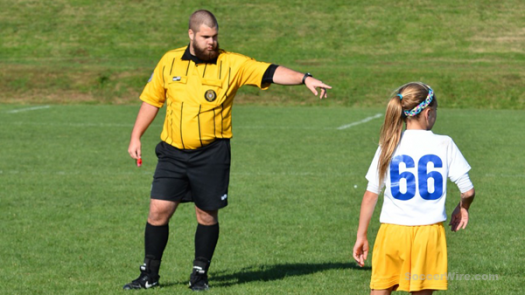Think first: Five simple ways to raise your team’s soccer IQ

For all the improved technical training going on in North America – and some steps in the team tactical training as well – soccer is still so far removed from our everyday culture that most players and youth coaches still lack some of the basic “soccer IQ” that is standard fare in most of the world.
 It’s actually pretty funny, given all the complaining here in the U.S. that too many coaches care mostly about winning, yet so many of those “winning” coaches don’t focus on soccer IQ more. Few other things can lead to more goals with so little actual on-field training.
It’s actually pretty funny, given all the complaining here in the U.S. that too many coaches care mostly about winning, yet so many of those “winning” coaches don’t focus on soccer IQ more. Few other things can lead to more goals with so little actual on-field training.
The detailed definition of “soccer IQ” is open to plenty of interpretation. But for the purposes here, I’m using it to describe “decision making” by players on the field that have nothing to do with technical skills or team tactics.
These five common decisions made by youth players are so common, it might be better just to call them “bad habits”, because you won’t ever see these things happening in the highest level of the game.
I know we shouldn’t expect youth players to be able to do all the things that happen at that highest level (or they’d already by there right?), but when it comes to making some decisions on the field, I think these five are completely teachable at the youth level. Coaches just need to recognize them and not allow players to get away with them in any training session.
+READ: Five mistakes soccer parents make with their players
1) Bad Passing Selection
…The first option is usually the best.
This takes many forms, and certainly the technical contributes because to see passing options you actually have to look up while the ball is at your feet! Three ways players don’t pass enough I see all the time:
- Players under no pressure dribble directly towards a player in an advanced position and wide-open themselves. If they even pass to them at all, it’s usually when they’ve moved so close that any defender can immediately pressure either player, and by the time all that dribbling takes place (with the head down) the entire defense has likely organized better cover and balance overall! Just pass the ball when the player is open (to their correct foot please)
- Players under no pressure (usually in defensive half), but without any clear downfield options won’t just pass the ball to an adjacent teammate and then get it right back. Rather they’ll hold it, do some pull backs, dribble a little, and if the defense is good enough, will end up having to play it back to the ‘keeper. Every pass doesn’t have to beat defenders or put someone through on goal. But every pass does keep a defense thinking and adjusting. Move the ball a lot even if it doesn’t advance field position.
 Once in the attacking half, midfielders aren’t taking opportunities to find their forward’s feet enough, even though it’s constantly an option at the youth level due to generally poor defensive organization. In other words there are a LOT of open passing lanes to find a teammate in a more advanced position with a pass that eliminates several opponents. Unfortunately I’d say at least 95% of passes forward from the middle third into the attacking third are in the air towards a running player more like the NFL than the EPL. Look for those feet and keep possession!
Once in the attacking half, midfielders aren’t taking opportunities to find their forward’s feet enough, even though it’s constantly an option at the youth level due to generally poor defensive organization. In other words there are a LOT of open passing lanes to find a teammate in a more advanced position with a pass that eliminates several opponents. Unfortunately I’d say at least 95% of passes forward from the middle third into the attacking third are in the air towards a running player more like the NFL than the EPL. Look for those feet and keep possession!
2) Abandoning Great Positions
…“Where the hell are you going?”
When they do pass, too often youth players immediately sprint forward before their teammate has even had a chance to touch the ball. It’s like a game of hot potato in the middle of a 100 yard dash! On a clear one-two opportunity in the attacking third where the initial passer was already “on the move” with the ball, this can be a great way to carve up a lazy defense. But when it happens during build-up play in the defensive and middle thirds of the field, it typically leaves the ball receiver with no immediate support (one of the basic principles, coach!). In the youth game without precision passing and poor first touches being more frequent, that’s a recipe for a turnover and counter attack almost every time – especially when the initial pass was square! It’s just not worth the risk.
Unless there’s another teammate in your space when you pass the ball away, or there is a clear opportunity to play a one-two that will lead to a scoring opportunity or transition into the final third, just pass the ball and move into even more space in case the receiver needs to play it back to you.
KEEP THE BALL as long as you can until the goal chance can be generated.
3) Don’t commit to blocking shots
 …Don’t just stand there!
…Don’t just stand there!
Watch any camera angle of an MLS or English Premier League game that shows the path of a shot from shooter to the goal and you’ll likely see several defenders lunging forward using slide-tackling technique from nowhere near any player. These players are anticipating the ball flight path from foot to goal and throwing everything on the line to get legs and feet into that path.
If there’s a ball in the back of your net and every effort wasn’t made to stop it even AFTER it leaves the shooter’s foot, then you didn’t try hard enough. The closer to the shooter the better, of course, since late deflections can ruin a goalkeeper’s best plans. But at least give yourself the option – and get to know your ‘keeper well (for instance, they’ll usually want to protect more far post but leave them to cover the near if you have a choice)!
4) Don’t shoot when it’s on
…You can’t score if you don’t shoot.
The one place where most American youth players look like Arsenal is around the edges of the box! Meaning, they don’t take openings to shoot that they worked so hard to create. Unlike Arsenal, however, this isn’t because they’re trying to walk the ball into the goal, it’s because they just don’t realize “it’s on”.
https://www.youtube.com/watch?v=0axoHxNl7Fw
It only takes a fraction of an opening to fire a shot, and if you’re facing goal with the ability to plant and fire from anywhere within your personal “effective shooting range” you should do so as often as possible – especially early in a game. Per No. 3 above, most youth players don’t really “get” the idea of blocking the most likely flight path of the ball, and deflections are your friend anyway. So shoot early and shoot often because there are a lot more openings than you think. Only the ball needs to “see” the goal, you don’t.
Even if you don’t score, defenders will start to over-commit as the game wears on and their coaches and teammates are yelling not to let you shoot. THAT is when you can cut past them and get your tap-in, or play the perfect pass… “the Arsenal Way”
 5) Don’t recognize easy chances after fouls
5) Don’t recognize easy chances after fouls
…Umm, the net is empty!
The one that always gets me going on a “lack of soccer IQ” rant is when a team is fouled near the top of the box and NO ONE from the attacking team grabs the ball right away and looks for the quick shot. Remember, the referee shouldn’t make you wait to restart unless you ask for 10 yards, so sometimes you need to give them a little whisper and eyeball them to “please move” so they know what you’re doing without you having to announce it to row Z.
Speaking of the ref, the opportunity for scoring like this is even easier when it was a controversial call and people start arguing with them. Sometimes the ball is just sitting there with the goalkeeper out at the PK spot, arguing from a distance with the goal gaping. In other cases the team will start to set up a wall a nearly-honest 10 yards away and the goalkeeper will go to the post to align them.. all without the attacking team actually having asked the referee to enforce the 10 yard rule. If you’re ready, you can pop the ball in the far post before anyone else knows what’s happening.
All the above are great opportunities for a “cheeky” goal that I’ve only seen attempted once in a youth game once in my life (by a team I wasn’t coaching). How many free kick goals over or around a wall have you actually seen scored by a 17 year old anyway? They’re a very low percentage chance anyway, and just about every time there’s a chance exploit a whistle in another way.
The quick-take free kick doesn’t have to be from direct shooting range either. Just having a couple of players getting to the box quickly and putting in a service before the defense can organize can be just as dangerous, as can be springing an odd man counter with a quick restart from midfield while half the opposing is still arguing.
The whole point of taking the field is to score goals, so this opportunity to out-smart an opponent is one of the easiest to learn, yet most rarely used IQ options in the youth game.
+READ: Five ways to develop soccer players during a blowout without disrespecting opponents
Best Soccer IQ Teacher is Watching High Level Games
These five, and many more happen all the time in every game in America, including college and even more subtly in MLS. And it’s often WORSE in the girls / women’s side of the game.
Why?
Because the girls don’t watch soccer on TV nearly as much as the boys, and watching soccer at the highest level is where you can see the decisions players make every second of every match. For tactical learning purposes, it’s even better to watch online, where some broadcasters are offering a “tactical camera” view, which always shows all 22 players on the field from a high vantage point.
Coaches need to spend more time encouraging watching and thinking about the game for this to improve. They need to spot the five tendencies above, and many more IQ issues during games and make notes to address them.
More teams need a culture of Soccer IQ if we’re going to truly produce a regular pipeline of world-class American players. And in the process, improve the overall quality of the game on every field in America.
What are some of your soccer IQ pet peeves? Share them below so we can all get smarter about the game we love!
SOCCERWIRE MARKETPLACE
- Adidas National Cup 2026
- Adidas Showcase 2025
- Adidas Preseason Clash 2025
- Capital Fall Classic 2025 - Register by October 1st
- Applications are Now Open for the 2026 Jefferson Cup
- Start the Season Strong at Loudoun Premier Cup!
- 50th Annual Rael Vodicka Memorial Tournament
- Soccer Marketing Internships at The St. James FC
- Job Opening: The St. James FC Goalkeeper Academy Coach
- Full-Time Director of Goalkeeping for The St. James FC











